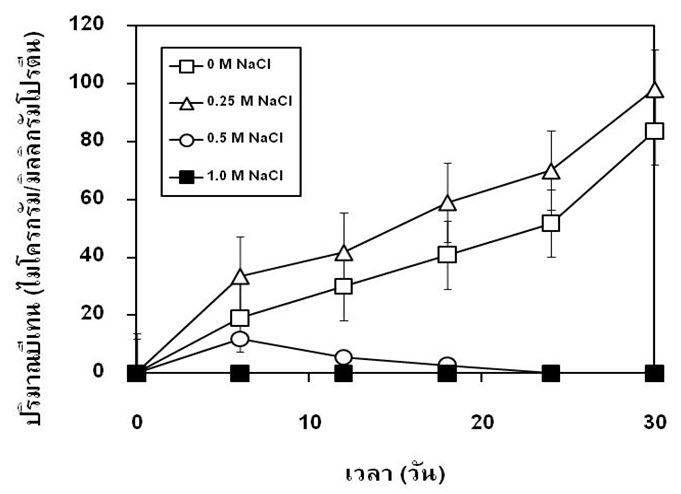ผลของความเค็มต่อการเจริญและปริมาณบีเทนของไซยาโนแบคทีเรียชนิดเส้นสาย Anabaena sp. Nostoc sp. และ Spirulina sp.
Main Article Content
Abstract
Potitorn Kanchitanurak, Kanokgarn Naktong, Chaiyasad Kachensuwan and Surasak Laloknam
รับบทความ: 10 เมษายน 2555; ยอมรับตีพิมพ์: 18 พฤษภาคม 2555
บทคัดย่อ
การเพาะเลี้ยงไซยาโนแบคทีเรีย Anabaena sp. Nostoc sp. และ Spirulina sp. ในอาหารเลี้ยง BG11 ภายใต้ภาวะความเค็มของเกลือโซเดียมคลอไรด์ที่ความเข้มข้น 0 – 1 โมลาร์ พบว่า ความเข้มข้นของเกลือโซเดียมคลอไรด์ที่เหมาะสมต่ออัตราการเจริญของ Spirulina sp. เท่ากับ 0.25 โมลาร์ ซึ่งเจริญได้ดีใกล้เคียงกับภาวะปกติที่ไม่เติมเกลือ ส่วน Anabaena sp. และ Nostoc sp. เจริญได้ดีในอาหารที่ไม่มีเกลือโซเดียมคลอไรด์ (0 M NaCl) และภาวะที่มีความเครียดจากเกลือโซเดียมคลอไรด์ที่ทำให้อัตราการเจริญของ Anabaena sp. ลดลงเป็นครึ่งหนึ่งของภาวะที่เหมาะสม เท่ากับ 0.25 โมลาร์ ในขณะที่ Nostoc sp. และ Spirulina sp. เท่ากับ 0.5 โมลาร์ จากนั้นติดตามปริมาณบีเทนของ Anabaena sp. Nostoc sp. และ Spirulina sp. ภายใต้ภาวะปกติและภาวะที่มีความเครียดจากเกลือ พบว่า ภายใต้ภาวะความเครียดจากเกลือไซยาโนแบคทีเรียทั้ง 3 ชนิด ให้ปริมาณบีเทนสูงกว่าภาวะปกติประมาณ 2 เท่า ดังนั้นอธิบายได้ว่าไซยาโนแบคทีเรียมีการสะสมบีเทนภายใต้ภาวะที่มีความเครียดจากเกลือโซเดียมคลอไรด์
คำสำคัญ: ไซยาโนแบคทีเรีย บีเทน ความเครียดจากเกลือ
Abstract
The growth of cyanobacterium Anabaena sp., Nostoc sp. and Spirulina sp. was stimulated by increasing of salinity range of 0 – 1 M NaCl in BG11 medium. The optimal growth rate of Spirulina sp. under salinity was 0.25 M NaCl nearest with 0 M NaCl, and the optimal growth rate of Anabaena sp. and Nostoc sp. were condition without NaCl (0 M NaCl), The salt stress condition is growth rate half of optimal growth rate of Anabaena sp., Nostoc sp. and Spirulina sp. as 0.25, 0.5 and 0.5 M NaCl, respectively. The betaine content in all cyanobacteria was determined under normal and salt stress conditions. At the salt stress condition, all cyanobacteria showed betaine content higher than normal condition about 2 folds. These results suggested that all cyanobacteria Anabaena sp., Nostoc sp. and Spirulina sp. were accumulated betaine under salt stress condition.
Keywords: Cyanobacteria, Betaine, Salt stress
Downloads
Article Details

This work is licensed under a Creative Commons Attribution-NonCommercial 4.0 International License.
References
บงกช บุญบูรพงษ์ อาภรณ์ บัวหลวง อรัญ อินเจริญศักดิ์ ยุวธิดา นิลผาย ปนัดดา พ่วงขวัญ อภิญญาณ บุญประกอบกูล และ สุรศักดิ์ ละลอกน้ำ. (2554). ผลของไกลซีน โพรลีน และกลูตาเมต ต่อการเจริญของไซยาโนแบคทีเรีย Synechococcus sp. PCC7942, Synechocytis sp. PCC6803 และ Aphanothece halophytica ภายใต้ภาวะปกติและภาวะที่มีความเครียดจากเกลือ. วารสารหน่วยวิจัยวิทยาศาสตร์ เทคโนโลยี และสิ่งแวดล้อมเพื่อการเรียนรู้ 2(1): 48–58.
สุรศักดิ์ ละลอกน้ำ. (2554). การปรับตัวของไซยาโนแบคทีเรียภายใต้ภาวะเครียดจากเกลือ. วารสารหน่วยวิจัยวิทยาศาสตร์ เทคโนโลยี และสิ่งแวดล้อมเพื่อการเรียนรู้ 2(1): 82–88.
Bohnert, H. J., and Jenzen, R.G. (1996). Strategies for engineering water-stress tolerance in plants. Trends Biotechnol. 14: 89–97.
Grieve, C. M., and Grattan, S. R. (1983). Rapid assay for determination of water-soluble quaternary-aminocompounds. Plant Soil. 70: 303–307.
Kapper, R. M., Kempf, B., and Bremer, F. (1996). Three transport systems for the osmoprotectant glycine betaine operate in Bacillus subtilis: character-ization of OpuD. J. Bacteriol. 178: 5071–5079.
Kemp, B., and Bremer, E. (1998). Uptake and synthesis of compatible solutes as microbial stress responses to high – osmolality environments. Arch. Microbiol. 170: 319–330.
Laloknam, S., Tanaka, K., Buaboocha, T., Waditee, R., Incharoensakdi, A., Hibino, T., Tanaka, Y., and Takabe, T. (2006). Halotolerant Cyanobacterium Aphanothece halophytica contains a Betaine transporter active at alkaline pH and high salinity. Appl. Environ. Microbiol. 72(9): 6018–6026.
Mackey, M. A., Norton, R. S., and Borowitzka, L. J. (1984). Organic osmoregulatory solutes in cyanobacteria. J. Gen. Microbiol. 130: 2177–2191.
Padan, E., and Schuldiner, S. (1996). Bacterial Na+/H+ antiporters: molecular biology, biochemistry, and physiology. In Handbook of Biological Physics, Konings, W. N., Kaback, H. R. and Lolkema, J. (eds.). Amsterdam, the Netherlands: Elsevier Science.
Waditee, R., Bhuiyan, M. N. H., Rai, V., Aoki, K., Tanaka, Y., Hibino, T., Suzuki, S., Takano, J., Jagendorf, A. T., Takabe, T., and Takabe, T. (2005). Genes for direct methylation of glycine provide high levels of glycinebetaine and abiotic-stress tolerance in Synechococcus and Arabidopsis. Proc. Natl. Acad. Sci. USA 102: 1318–1323.
Waditee, R., Hibino, T., Nakamura, T., Incharoensakdi, A., and Takabe, T. (2002). Overexpression of a Na+/H+ antiporter confers salt tolerance on a freshwater cyanobacterium, making it capable of growth in sea water. Proc. Natl. Acad. Sci. USA 99: 4109–4114.
Zhu, J.-K., Hasegawa, P. M., and Bressan, R. A. (1997). Molecular aspects of osmotics stress in plant. Crit. Rev. Plant Sci. 16: 253–277.
